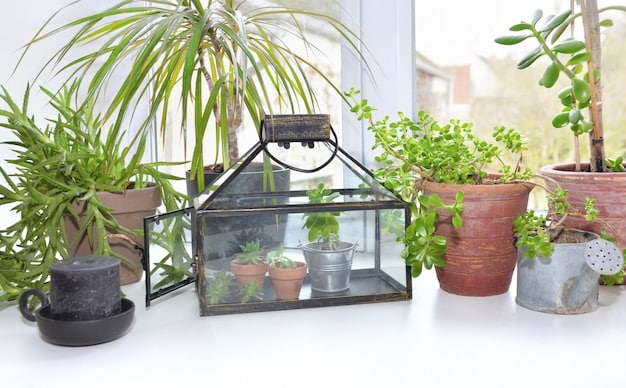Creating a Sacred Space: Design Your Spirit-Nurturing Home

Creating a sacred space involves intentionally designing your home environment to foster peace, reflection, and spiritual well-being, transforming it into a nurturing sanctuary that supports your inner self.
In today’s fast-paced world, finding moments of tranquility can feel like a luxury. Creating a sacred space: designing a home environment that nurtures your spirit is not just about interior design; it’s about curating an environment that promotes inner peace, reflection, and spiritual growth, right within the walls of your own home.
What Does it Mean to Create a Sacred Space?
Creating a sacred space goes beyond simply decorating a room. It is about intentionally designing an area that resonates with your inner self, fostering feelings of peace, comfort, and spiritual connection.
It’s a personal endeavor, tailored to your individual beliefs, practices, and needs. This space becomes a sanctuary where you can disconnect from the external world and reconnect with your inner spirit, whether through meditation, yoga, reading, or simply being.
Defining your Intentions
Before you begin redesigning your physical space, take some time to reflect on your intentions. What do you hope to gain from your sacred space? Are you seeking a place for meditation, creative expression, or simply a quiet escape? Understanding your goals is the first step in creating an environment that truly supports your spiritual journey.
The Significance of Personalization
A crucial element of a sacred space is its personalization. This is not a one-size-fits-all approach. It should reflect your unique personality, preferences, and spiritual beliefs. Incorporate objects, colors, and symbols that hold personal meaning for you. This will deepen your connection to the space and enhance its ability to nurture your spirit.

In essence, creating a sacred space is about transforming a physical environment into a spiritual haven, a place where you can find solace, inspiration, and a deeper connection to yourself and the universe. It’s a journey of self-discovery and intentional design that can profoundly enhance your well-being.
Selecting the Right Location in Your Home
The location of your sacred space within your home is a crucial consideration. Ideally, it should be an area that is relatively quiet and free from distractions. This doesn’t necessarily mean it needs to be a completely separate room; it could be a corner of your bedroom, a sunlit spot in your living room, or even an outdoor space like a balcony or garden.
The key is to choose a location that feels comfortable, safe, and conducive to relaxation and introspection. Consider the natural elements of the space, such as light, air quality, and noise levels, and how they can impact your overall experience.
Assessing Existing Spaces
Take a tour of your home and evaluate potential locations for your sacred space. Consider the following factors:
- Privacy: How much privacy does the space offer? Can you easily block out noise and visual distractions?
- Natural Light: Does the space receive ample natural light? Natural light can have a positive impact on mood and energy levels.
- Air Quality: Is the air in the space fresh and clean? Good ventilation is essential for creating a healthy and inviting environment.
- Energy: How does the space feel to you? Does it feel calming and inviting, or does it feel cluttered and overwhelming?
By carefully assessing your existing spaces, you can identify the location that is best suited for transformation into a nurturing sacred space.
Transforming Underutilized Areas
Don’t be afraid to think outside the box when selecting a location for your sacred space. An underutilized corner, a neglected closet, or even a small balcony can be transformed into a beautiful and functional sanctuary with a little creativity and effort. Consider how you can repurpose existing spaces to create a dedicated area for spiritual practice and self-care.
Choosing the right location is a vital step in creating a sacred space that truly supports your well-being. By considering factors such as privacy, natural light, and energy, and by being open to transforming underutilized areas, you can create a sanctuary that is perfectly suited to your needs.
Incorporating Natural Elements
Bringing elements of nature into your sacred space can have a profound impact on its energy and atmosphere. Natural elements such as plants, stones, water, and wood can help to create a sense of calm, connection, and grounding, fostering a deeper sense of well-being.
Think about how you can incorporate these elements into your space in a way that feels authentic and meaningful to you. Whether it’s a collection of crystals, a small indoor fountain, or a lush green plant, natural elements can help to transform your space into a true sanctuary.

Plants: Bringing Life and Energy
Plants are a wonderful addition to any sacred space. They not only add a touch of beauty and vibrancy but also help to purify the air and create a sense of connection to nature. Choose plants that resonate with you and that are relatively easy to care for.
Stones and Crystals: Grounding and Healing
Stones and crystals have been used for centuries for their healing and energetic properties. Incorporating them into your sacred space can help to create a sense of grounding, balance, and protection. Choose stones and crystals that resonate with your intentions and that you feel drawn to.
- Amethyst: Promotes calm and relaxation.
- Rose Quartz: Fosters love and compassion.
- Clear Quartz: Amplifies energy and clarity.
- Black Tourmaline: Provides protection and grounding.
Integrating natural elements into your sacred space is a powerful way to enhance its energy and create an environment that supports your spiritual growth and well-being. By carefully selecting and arranging these elements, you can create a sanctuary that feels both beautiful and deeply nourishing.
The Power of Color and Lighting
Color and lighting play a significant role in shaping the mood and energy of your sacred space. Different colors evoke different emotions, and the quality of light can impact your overall sense of well-being. By carefully considering these factors, you can create a space that is both visually appealing and energetically supportive.
When choosing colors for your sacred space, consider your intentions for the space. Are you seeking a calming and relaxing environment? If so, opt for soft, muted tones such as blues, greens, and purples. Do you want to create a space that is energizing and uplifting? Consider incorporating brighter colors such as yellows, oranges, and pinks.
Understanding Color Psychology
Understanding the basics of color psychology can help you make informed decisions about the color palette for your sacred space:
- Blue: Calming, peaceful, and promotes relaxation.
- Green: Balancing, grounding, and connects to nature.
- Purple: Spiritual, intuitive, and promotes creativity.
- Yellow: Uplifting, energizing, and fosters optimism.
Optimizing Natural and Artificial Light
Maximize natural light whenever possible, as it has a positive impact on mood and energy levels. Use sheer curtains or blinds to filter the light and create a soft, diffused glow. Supplement natural light with artificial lighting that is warm and inviting.
Consider using dimmer switches to adjust the intensity of the light and create a more relaxing atmosphere. Candles can also be a wonderful addition, providing a soft, flickering light that promotes calm and introspection. Experiment to find the perfect balance of color and light to nurture your spirit. This balance will greatly increase the power of your Sacred Space.
Careful consideration of color and lighting can significantly enhance the atmosphere of your sacred space. By understanding the psychological effects of different colors and optimizing both natural and artificial light, you can create a sanctuary that is both visually appealing and energetically supportive of your spiritual journey.
Creating an Altar or Focal Point
An altar or focal point can serve as a powerful symbol of your intentions and beliefs within your sacred space. It can be a place to focus your attention during meditation, prayer, or other spiritual practices, helping you to connect with your inner self and the divine.
Your altar can be as simple or as elaborate as you like, depending on your preferences and beliefs. It can include items that hold personal meaning for you, such as crystals, candles, statues, photos, or other objects that inspire you.
Designing your Altar
When designing your altar, consider the following guidelines:
- Choose a central location: Place your altar in a prominent location within your sacred space.
- Select meaningful objects: Choose items that resonate with your intentions and beliefs.
- Arrange with intention: Arrange the items on your altar in a way that feels balanced and harmonious.
The Significance of Symbols
Incorporate symbols that hold personal meaning for you onto your altar. This might include religious symbols, nature symbols, or other images or objects that remind you of your values and aspirations.
For example, a feather might represent freedom and inspiration, while a stone might symbolize grounding and stability. Choose symbols that speak to your heart and that enhance your connection to your spiritual practice. A focal point or Alter can make the space that much more meaningful and help you connect with your spiritual side.
Creating an altar or focal point is a deeply personal and meaningful way to enhance your sacred space. By carefully selecting and arranging objects that resonate with your intentions and beliefs, you can create a powerful symbol of your spiritual journey and a focal point for your practice.
Decluttering and Cleansing Your Space
Before you can truly create a sacred space, it’s essential to declutter and cleanse the physical environment. Clutter can create stagnant energy and make it difficult to relax and focus, while cleansing can help to remove negative energies and create a fresh, inviting atmosphere.
Start by removing any items that you no longer need or use. Be honest with yourself about what you truly value and what is simply taking up space. Once you’ve decluttered, take the time to thoroughly clean the space, paying attention to surfaces, corners, and hidden areas.
Cleansing Rituals
There are several ways to cleanse your space energetically. Here are a few options:
- Smudging: Burn sage, palo santo, or other sacred herbs to clear negative energy.
- Sound Cleansing: Use singing bowls, bells, or chimes to create vibrations that dispel stagnant energy.
- Salt Cleansing: Place bowls of salt in the corners of the room to absorb negative energy.
With a space that has been cleansed and decluttered, it opens up the possibilities for you and allows for new energy.
Maintaining a Clear Space
Once you’ve decluttered and cleansed your space, it’s important to maintain it on a regular basis. Make it a habit to put things away after you use them, and to regularly dust and clean the space. This will help to keep the energy flowing and ensure that your sacred space remains a nurturing sanctuary.
Decluttering and cleansing your space is a vital foundation for creating a true sanctuary. By removing physical and energetic clutter, you create an environment that is conducive to relaxation, reflection, and spiritual growth. A well-decluttered space equals a well decluttered mind and creates a space for peace and gratitude.
| Key Point | Brief Description |
|---|---|
| 🏡 Define Intentions | Clarify goals: meditation, creativity, peace. |
| 🌿 Natural Elements | Incorporate plants, stones for grounding energy. |
| ✨ Declutter Space | Remove unnecessary items and cleanse the space. |
| 🕯️ Altar/Focal Point | Create with meaningful objects for focus and connection. |
Frequently Asked Questions
▼
Creating a sacred space is important because it provides a dedicated area for relaxation, reflection, and spiritual growth, promoting mental and emotional well-being in today’s busy world.
▼
Ideally, locate your sacred space in a quiet area with minimal distractions, good natural light, and fresh air. It could be a corner of a room or an entire room if space allows.
▼
Include elements that resonate with you, such as plants, crystals, candles, soft textiles, and items that symbolize your beliefs and intentions for the space.
▼
You can cleanse the energy by smudging with sage or palo santo, using sound healing tools like singing bowls, or placing bowls of salt in the corners of the space for several days.
▼
Maintain your sacred space regularly by decluttering, cleaning, and refreshing the energy. Aim to do a deep cleansing once a month and a quick tidy-up weekly to keep it vibrant.
Conclusion
Creating a sacred space: designing a home environment that nurtures your spirit can significantly enhance your well-being. By intentionally designing a space that resonates with your inner self, incorporating natural elements, and maintaining a clutter-free environment, you can create a sanctuary that supports your spiritual growth and promotes inner peace.





